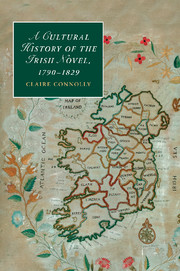Chapter 2 - Landscape and map
Published online by Cambridge University Press: 05 December 2011
Summary
On 19 June 1802 an Irish woman travelling on the Continent wrote a letter home describing ‘dining at the Thuilleries with Bonaparte’. The letter features an entertaining account of Napoleon’s bad manners, Madame Bonaparte’s gaudy dress and Talleyrand’s ‘cormorant’ appetite, as well as a reported conversation between Catherine Wilmot and the French officer who had handed her into dinner:
General Grouchy was second in command in the affair of Bantry Bay, on board the ‘Fraternité’, and had every intention of snapping the grappling Irons which attach Ireland to England. We laugh’d heartily at the different circumstances under which our acquaintance wou’d have commenced had the business succeeded. However I took care to tell him ‘had their philanthropic undertaking prosper’d as happily in Ireland as it did across the Alps, I should expect by this time to see our little Island hung up as a curiosity in the Louvre amongst the Italian Trophies’.
Catherine Wilmot, the daughter of a retired army captain, was travelling with the wealthy and unhappy Lady Margaret Mount Cashell. Wilmot regularly sent letters to her brother at home in Cork, detailing Paris encounters that included meetings with Matilda, the widow of Theobald Wolfe Tone, and with Robert Emmet. Her dining companion, General Emmanuel de Grouchy, was Marshal of France and later to earn his country’s censure for failure to assist Napoleon at the battle of Waterloo. The conversation is unusually explicit in framing the island of Ireland not only as spectacle, but as art object hanging on the walls of a museum alongside other spoils of conquest. In Wilmot’s version of the failed French attempt to land on the west Cork coast in 1796, Ireland is scaled down to become a decorative museum-size replica of itself: hanging on the walls of a museum alongside landscape paintings looted from Italy.
- Type
- Chapter
- Information
- A Cultural History of the Irish Novel, 1790–1829 , pp. 47 - 84Publisher: Cambridge University PressPrint publication year: 2011

